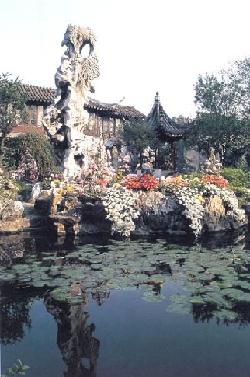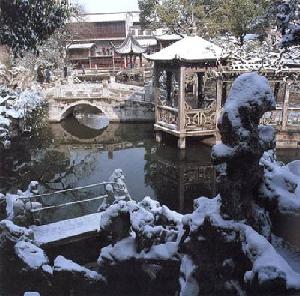Suzhougardens are the most outstanding representatives of Chinese classical gardens. Compared with royal gardens, they are pure, lofty, elegant and free from conventions, and are taken as their highest pursuit, brimming with a strong scholarly style.Suzhouis a place of gardens and up to now has a collection of at least 186 gardens, among which the following four are of great significance:
Zhuozheng Garden (The Humble Administrator's Garden)

The Humble Administrator's Garden is the representative of gardens inSuzhou. Around 1513 during the Ming Dynasty (1368-1644), the imperial inspector Wang Xianchen, being sick of officialdom, returned toSuzhouafter retiring from public life and built this garden and named itZhuozhengGarden, or the Humble Administrator's Garden Focused on a central pond with pavilions, terraces, chambers, and towers located nearby, the garden is divided into three parts: the eastern, middle and western parts.
The eastern part features mountains and ponds, with Suxiang Hall and Lanxue Hall as the representative architectures. The main building, Mandarin Duck Hall, was where the master used to entertain his guests with operas and other performances.
The middle part of the garden with an area of 18.5mu, one third of which is water, is the cream of all, featuring the Lotus Pond, Yuanxiang Hall and two mountain islands. The east and west mountain islands stand out of the water, and the water surface is separated into several blocks by small bridges and dikes. In this area there are several pavilions which are suitable for sightseers to enjoy the sceneries around the lotus pond. It has marvelous mountains, clear water, exquisite buildings and exuberant trees and flowers, reminiscent of the scenery in Southland.
The Humble Administrator's Garden is a typical example of the art of horticulture south ofYangtze Riveras well as a treasure house containing arts of architecture, calligraphy, carving, painting, and bonsai. It was listed as cultural relics of national importance in 1961.
Liu Garden (The Lingering Garden)

With an area of 30mu(2 hectares) and situated outside the Cang Gate of Suzhou City, the Lingering Garden was originally the East Garden of Xu Shiqin in the Ming Dynasty (1368-1644), later it became the property of Liu Rongfeng of the Qing Dynasty (1644-1911) and was renamed Haibi Villa, popularly known as "Liu Garden". In the 12th year (1873) of the reign of Tongzhi, it was purchased, expanded and overhauled by the new owner, Sheng famlily, who renamed it "theLingeringGarden".
Today, centering the pond, the garden is separated into the eastern, middle, northern and western parts. To the south of the pond are groupings of garden courts and elegant buildings, such as Mingse Building; to the north are rockeries and pavilions; to the west are rockeries with a long corridor zigzagging to all parts of the garden; and to the east are zigzag corridors and Guanyun Courtyard which is best famous for its 6.6-meter-high and 5-ton-weighty Guanyun Peak, the only complete Taihu Lake limestone and the biggest among the rockworks in Suzhou gardens.
In theLingeringGarden, the buildings, pavilion, terrace, hall and tower are linked by a 600-meter-long corridor. Its wooden walls have fancy cut-through window through which visitors can enjoy the surrounding scenes; both the windows and the engravings are regarded as masterpieces of their respective kinds.
Canglang Pavilion (The Surging Waves Pavilion)

Canglang Pavilion, also named the Surging Waves Pavilion and located south ofSuzhouCity, is the oldest garden among the existing classical gardens ofSuzhou. The area used to be the private garden of a Prince of the Five Dynasties (907-960). During the Northern Song Dynasty, the scholar Su Zimei built a pavilion in the garden and named it Canglang Pavilion. The garden, connected by a long roofed walkway, features a range of man-made mountains on the inside and waterscapes on the outside. To enter the garden, one must proceed past an expanse of water over a zigzag bridge of stone and through the entrance. It is at this point that one catches sight of a man-made mountain covered with age-old trees and bamboos.
The Mingdao Hall (Enlightened Way Hall), located to the south of the mountains, is the major building of the garden. It was said to have been a site for lectures during the Ming Dynasty (1368-1644). Surrounded by verdant trees, it appears simple but dignified. On the walls of the hall hang three rubbings of the Song Dynasty steles, which are pictures of astronomy, Song Dynasty vehicles and a map of Pingjiang (today'sSuzhou) in the Song Dynasty. Inside the hall there is a wall inlaid with more than 500 stone statuaries of figures related to the history ofSuzhou.
In the southwest part of the garden is a stone cave in rockeries, on which stands a pavilion for people to enjoy scenery inSuzhou.
Shizi Garden (The Lion Grove Garden)

Located in the northeast part of Suzhou City, the Lion Grove Gardenis the representative of gardens of the Yuan Dynasty (1271-1368). It was first built in 1350 by Monk Tianru and his disciples, as a memorial to their master, Monk Zhongfeng. Because there were a lot of grotesque rocks in the garden resembling lions, the garden was thus named as the Lion Grove. With an area of 10,000 square meters, the Lion Grove Garden has reputed as the "Kingdom of Rockery" for a long time.
Covering nearly half of the total area of the garden, these rockworks, made fromTaihuLakelimestone, were ingeniously piled up in layers to form peaks, crags, valleys and caverns. There're 9 mountain paths, 21 caves, and innumerable grotesque rocks, many of them resembling lions with different and striking poses, such as dancing lions, roaring lions, a couple of fighting lions, and lions playing with a ball.
It was said that Emperor Qianlong of the Qing Dynasty once visited here and wrote an inscription "Zhenqu" (True Delight) to describe the beauty of the garden, which is now hung on the True Delight Pavilion. The long corridor zigzags throughout the garden, with walls carved with 67 pieces of calligraphy works of famous Chinese calligraphers. Other famous architectures include Wen Tianxiang Poem Steles Pavilion and Imperial Steles Pavilion, etc.










